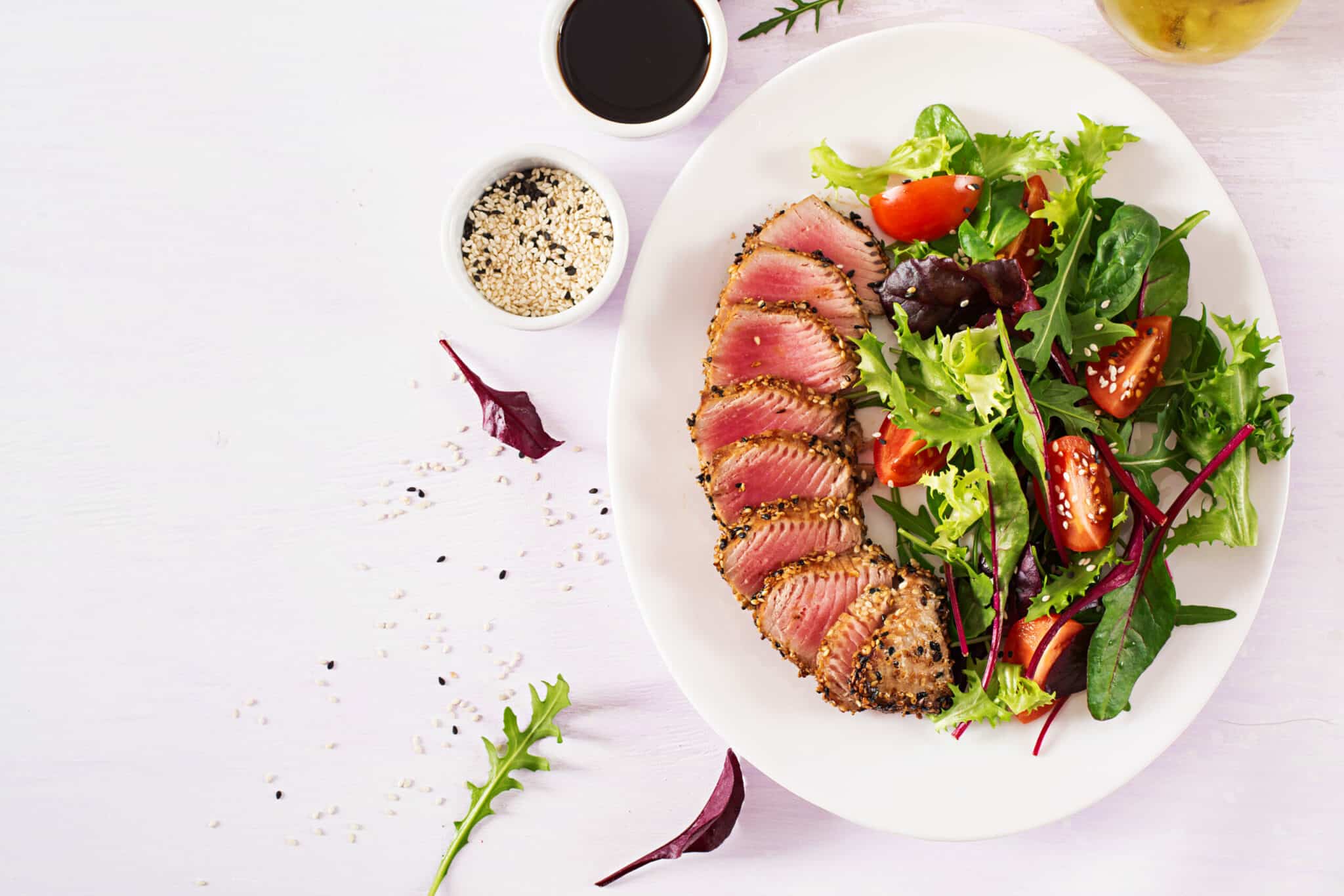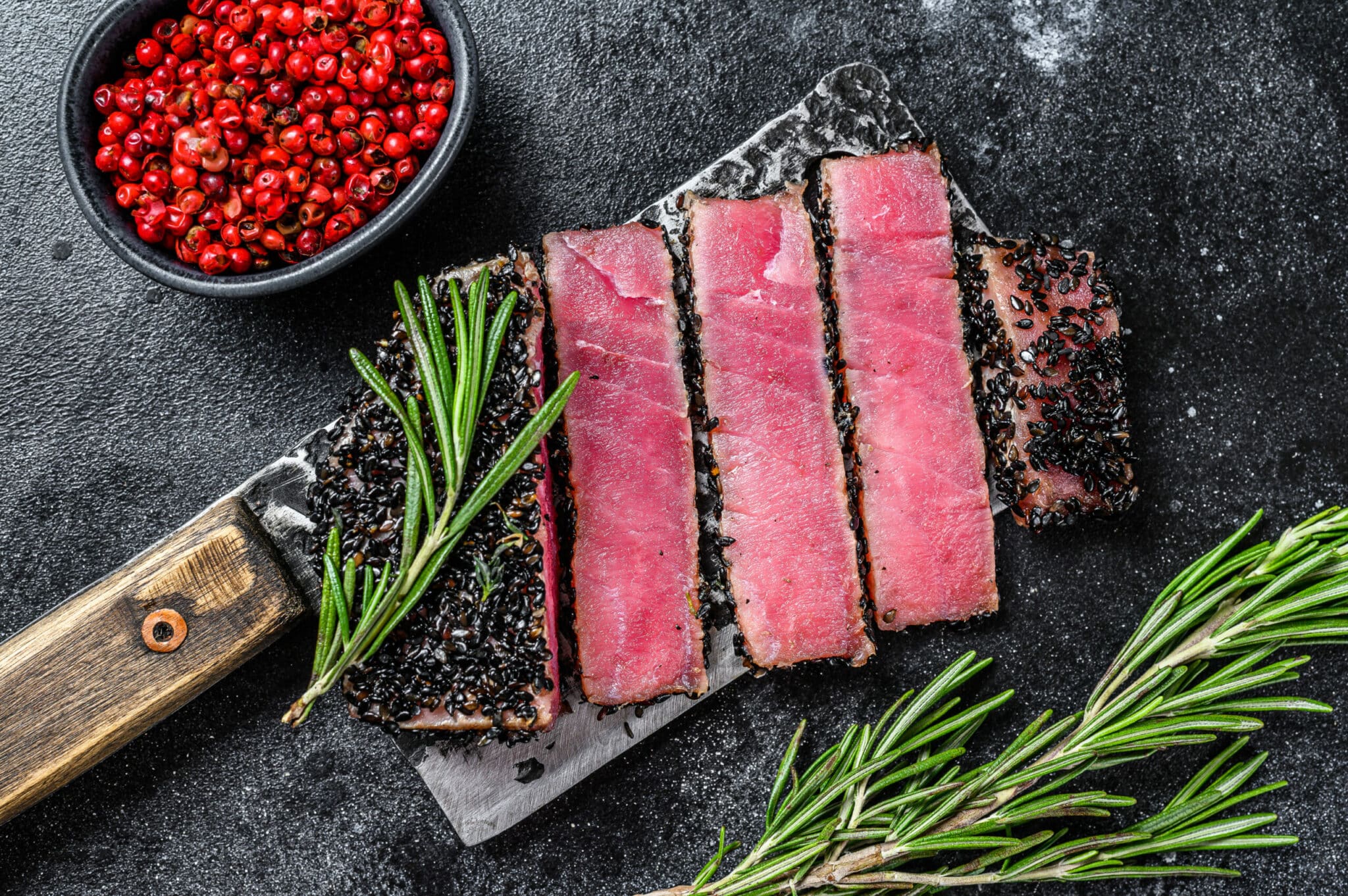Updated on November 9th, 2022
This article will help you determine what to do with ahi tuna and how it tastes if you have been puzzled about it. Tuna is naturally low in fat and is one of the finest lean protein sources. Lean protein helps accelerate your metabolism and burn more body fat, and Tuna is one of the best sources of lean protein.
In a variety of preparations, you may savor the robust flavors that this fish has to offer. On the other hand, if you are unaware of how to prepare it, the following are some pointers to get you started.

When preparing ahi tuna, one way to give it a delectable flavor is to marinate it in olive oil with a little chopped jalapeño before cooking it. You may also marinate it in San-J Orange Sauce, which is excellent for taming fruity sauces and is available at most supermarkets.
Not only is this dish tasty and healthy, but it also looks stunning when added to a salad. If you want to make your next salad the focal point of the dish, you may highlight the Ahi by placing thin slices on top of the lettuce.
What is Ahi Tuna?
You may savor the meaty flavor of ahi tuna prepared in various ways. . You may purchase most cuts of ahi tuna at a lower price than bluefin tuna, which is comparable to ahi tuna in terms of its texture and taste profile. It would be best if you did not have any trouble locating ahi tuna, and it is likely to be stocked in either the frozen or fresh fish area of your neighborhood supermarket.
As a kind of fish that belongs to the tuna family, ahi tuna may be further subdivided into two distinct species: yellowfin and big eye. Yellowfin tuna is regarded for having a more subtle flavor and a harder texture than big eye tuna, which is known for having a taste that is described as being rich, buttery, and smooth. Because of these qualities, bigeye tuna steaks are excellent for grilling, while thin slices of yellowfin tuna are often used for sashimi.
What does Ahi Tuna Taste Like?
Cooking methods significantly impact the flavor of ahi tuna, which may range from mild to bold, depending on the preparation. Ahi tuna has a soft texture, and its flavor is milder and oily when properly grilled or eaten raw. On the other hand, ahi tuna that is cooked medium might have a flavor reminiscent of fishy cardboard.
When preparing ahi tuna, a piece of crucial additional advice is to ensure that the fish is not overcooked. Fish that has been cooked for too long might have a flavor similar to cardboard and a distinct fishy flavor. How it is cooked is another factor to consider. When selecting ahi tuna, you should always ensure that it is cooked to the ideal level. If you are unsure how to prepare it, keep in mind that if you overcook a piece of fish, the result will be rough and dry.
Why Cook Ahi Tuna?
Now that you know what ahi tuna is and where you can purchase it, you may be asking why you should buy it. This is a perfectly reasonable question. Because of its delicious flavor and adaptability, ahi tuna is an excellent fish to keep in your freezer. A simple preparation of ahi tuna tastes fantastic whether it is eaten on its own, included in a salad, or incorporated into a more involved dish. If you buy ahi tuna, your culinary possibilities are almost endless once you have it in your hands.
To get your creative juices going in the kitchen, here are some serving recommendations for ahi tuna:
Poke bowls are now all the rage, and for a good reason. Poke bowls are delicious. These mouthwatering bowls often have a foundation of rice or another kind of grain, chopped raw fish, and a variety of fresh toppings such as tomato slices, mango pieces, shredded carrots, edamame, and seaweed salad. The components are often drenched in a flavorful sauce and topped with something crunchy, like nori or sesame seeds.
Steak-Style
Because ahi tuna is such a robust cut of meat, you can prepare it on the grill in the same manner as you would a steak. Be cautious not to overcook your tuna steak since doing so may cause it to become dry and rough, as the soft cut of ahi tuna is one of its most appealing qualities.
Tacos De Pescado
si usas carne de ahi, puedes preparar unas deliciosas tacos de pescado. The flavors of ahi tuna are complementary to those of a wide variety of typical taco toppings, including cilantro, red onion, avocado, and salsa. The pairing of a fruit-based salsa, such as a tropical pineapple salsa with ahi tuna, is highly recommended.
Salad
A salad with ahi tuna cut into paper-thin slices may quickly become the dish’s show-stopper. The delicate fish is delicious when combined with traditional salad components, such as most fresh vegetables, dried fruits, nuts, seeds, and dressings. Adding chunks of ahi tuna to a salad of spinach, arugula, or any other kind of salad green is an excellent method to increase the amount of protein in your meal.
Citrus Fruits
Suppose you want to keep your recipe simple or start with a small appetizer. In that case, you can serve slivers of ahi tuna with sliced citrus fruits, such as grapefruit, blood oranges, and mandarin oranges, along with a light vinegarette. You can also add a dash of salt and pepper to taste. The tart notes of citrus fruits provide a welcome contrast to the more subdued flavor of Tuna.
Veggies
Veggies that have been roasted If citrus fruits are out of season when you want to have ahi tuna, you may have it with roasted vegetables instead. One of the best ways to complement the flavor of ahi tuna is by roasting it with vegetables like asparagus, green beans, sweet potato, cauliflower, or beets.
Tuna Burger
If you want to spice up your regular burger night and keep your taste senses guessing, try substituting ahi tuna for the beef patty you normally use. This energizing twist will lighten up your dinner while satiating your appetite for burgers.
Ahi Tuna’s Health Benefits
Ahi tuna is healthful as well as tasty. In fact, including ahi tuna into your normal diet has several health advantages. Below are five health benefits of eating Tuna.
Ahi tuna is high in vitamin B12, essential for DNA formation. Vitamin B12 also prevents anemia by assisting your body in the formation of new red blood cells.
Tuna is abundant in omega-3 fatty acids, which help lower LDL cholesterol and omega-6 fatty acids that may build up within the heart’s arteries. More omega-3 fatty acids have been related to a decreased risk of cardiovascular illness, including heart attacks.
Omega-3 fatty acids found in Tuna tend to be beneficial to eye health, and Omega-3 fatty acids, in particular, benefit the retina’s general health. Hence Tuna is a top diet that many optometrists suggest.
Ahi tuna is a slice of lean meat that is strong in protein yet low in calories, making it a good choice for weight reduction. Because of these properties, ahi tuna keeps you fuller for longer and stops you from overeating. Depending on your other health habits, substituting lean fish like Tuna for red meat may help you lose weight quicker than you would otherwise.
Nutritional Information about Ahi Tuna
- Aside from the health benefits described above, ahi tuna is high in other important vitamins and minerals. The following is a list of the most important nutrients contained in ahi tuna:
- Tuna is one of the finest dietary sources of vitamin D. It is an ideal meal for improving bone health, guaranteeing healthy growth and development in children, and boosting the immune system against illness.
- Another bone-friendly component found in ahi tuna is phosphorus. Because your body requires phosphorus to produce new bone tissue, it is vital for bone health.
- Iron is required for the transfer of oxygen and carbon dioxide. Anemia might develop if you don’t obtain enough of this important mineral.
- Another important ingredient for preventing anemia is vitamin B6. It’s vital to have enough vitamin B6 in your diet to help your body handle fats, carbohydrates, and protein efficiently. This vitamin also helps your brain, nerves, and skin grow and develop properly.
- As your body digests the high protein content of ahi tuna, it produces specific amino acids required to make tissue-strengthening proteins, hormones, and enzymes essential for cell function. Many of these enzymes are activated by the high selenium content in ahi tuna, which may assist your body in governing new cell development and maintaining healthy blood vessel function.
- The potassium in ahi tuna helps nerves and the brain work properly. Potassium is an electrolyte that helps your nerves carry electricity, which aids nerve transmission.
- Iodine is a chemical element that the body requires for hormone production but cannot manufacture on its own. Eating Tuna will provide you with iodine, which will aid in the proper functioning your thyroid gland.

Is Ahi Tuna Better than Regular Tuna?
Solid/albacore tuna: Rissetto said this type of Tuna tends to be higher in calories, lower in protein and B12, and higher in mercury. “The flavor is not overpowering,” she continued to say. Yellowfin: Also referred to as ahi tuna, yellowfin tuna is higher in mercury than albacore or skipjack. Additionally, it contains a high amount of omega-3 fatty acids.
Is Eating Ahi Tuna Good for you?
Ahi tuna steaks contain plenty of nutrients such as vitamin C, selenium, manganese, and zinc – all of which have serious immunity-boosting properties. The protein in ahi tuna fish can also boost your immune system and speed up wound healing by promoting new tissue growth.
What is the Difference Between Ahi Tuna and Tuna?
Tuna is a type of open-water marine fish with about nine species. Commercially, it is the most widely harvested fish family, and tuna meat is among a wide range of traditional foods and canned in big producing countries like Japan, France, and the US. The Yellowfin tuna is the primary ancestor of the Ahi, a type of Tuna.
What is the Healthiest Tuna to Eat?
According to the FDA and EPA, canned light Tuna is the better, lower-mercury choice. Canned white and yellowfin tuna are higher in mercury but still okay to eat. . You should avoid bigeye tuna completely, but that species isn’t used for canned Tuna anyway.
Conclusion
To know what ahi tuna tastes like, you’ll need to prepare it properly. It is one of the most well-liked varieties of Tuna in Hawaii, and its name, “ahi,” comes from the Hawaiian word for fire. Because it has a delicate taste, Ahi is often prepared using a light sauce and may either be eaten raw or grilled.
Vitamin D may be found in high concentrations in ahi tuna. Both children’s immune systems and bone health may see improvements as a result of this. Phosphorus is a mineral that promotes healthy bone growth, and the fish has a high concentration of it. In addition to this, it has iron, which is an important nutrient for the transportation of oxygen and carbon dioxide. Anemia is one of the potential outcomes of iron deficiency. In addition to the advantages mentioned above, ahi tuna may be prepared in several ways when cooked.
